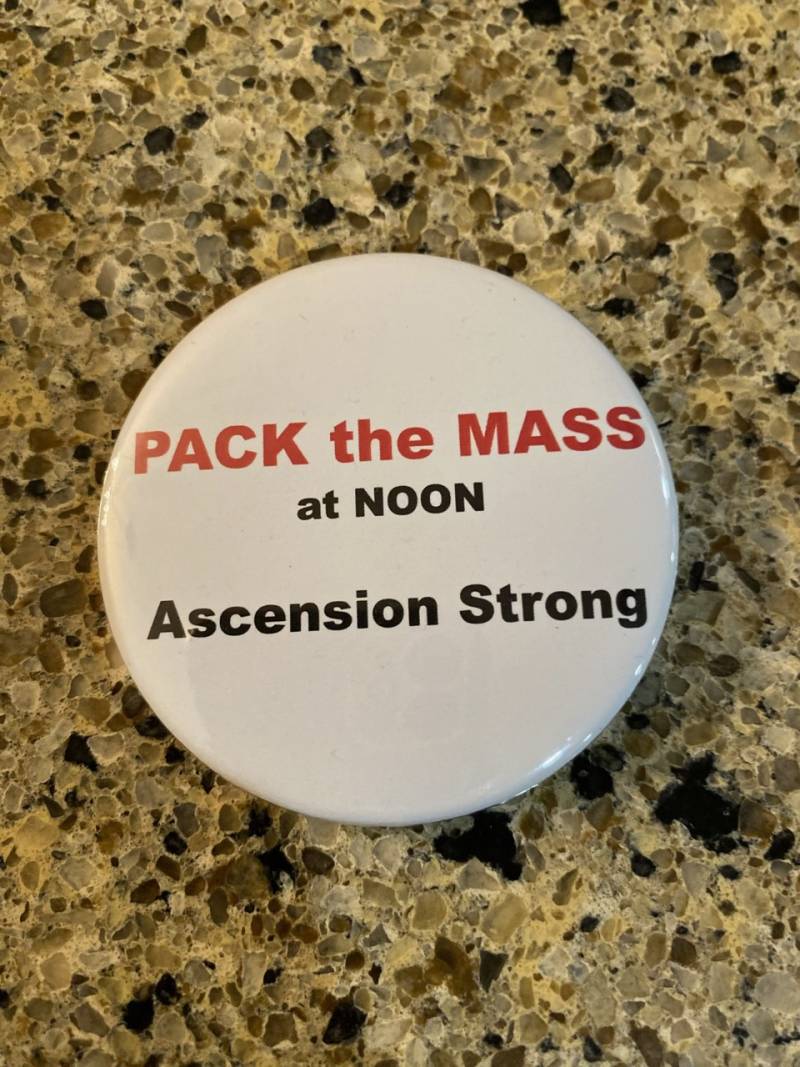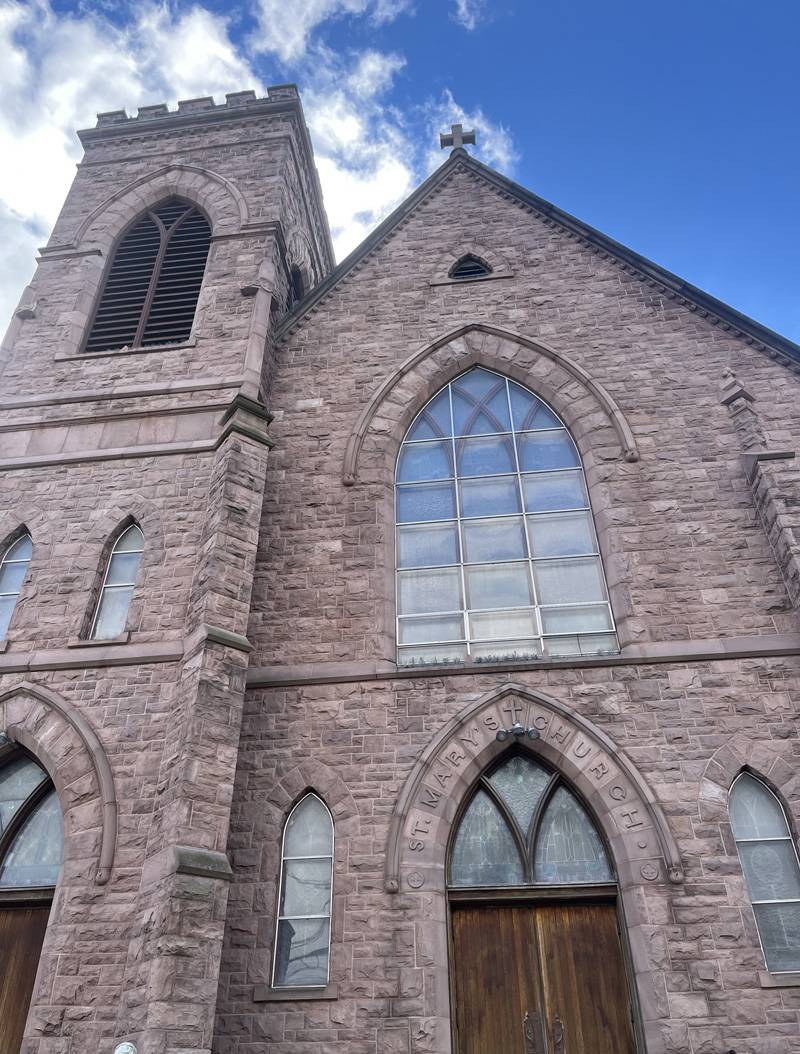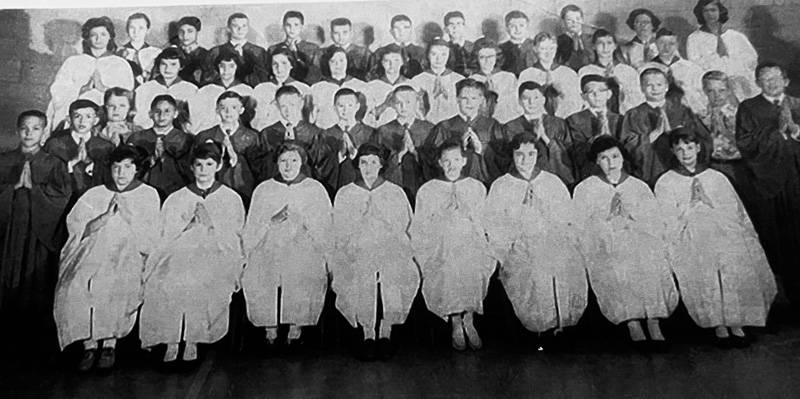Around 1915, my father's family moved from Mendon, New York, to Batavia. My grandparents, James D. and Catherine Nussbaumer Reilly, raised five children at 27 Cedar Street in the east end of town. My grandfather was a railroad man ( Workin' On The Railroad,The Batavian, 11/20/2020), so the house they purchased was directly next to the four lines of the New York Central.
The family was Catholic, so they attended St. Joseph's Church on East Main Street, and the children attended St. Joseph's School. The Reverend T. Bernard Kelly was the administrator of the church and school and, for some reason, passed my father ahead two grades, so he ended up graduating from Batavia High School at the age of 15. He always regretted this as he later realized he was too young and immature to be a high school grad. Well-known Batavia newspaper columnist Dan Winegar even wrote a story about it.
My dad and his family continued to be parishioners at St. Joseph's, and in 1944, when he was an officer in the Army Air Corps, he and my mom were married there with Father Kelly as the officiant. My mother had grown up as a non-practicing Protestant but converted to Catholicism when she married my dad.
Switching Churches
I was born in 1947 and after a year of renting an old mill house at Seven Springs my parents bought a house on Thomas Avenue more toward the west end of the city. This area was in St. Mary's Church Parish and when it started an elementary school in 1952 that sealed the deal for us to change churches and we stayed as congregants of that Church at least until I graduated from the school following 8th grade in 1960.
St. Mary's Church is on Ellicott Street near the corner of Evans. It was built there and opened in 1907. Msgr. Edward Ferger became the pastor of St. Mary's in 1939, and around 1950, he decided to proceed with his idea to start a Catholic High School in Batavia and build an elementary school for the Church on the same property.
Land was purchased on Union Street, which parcel went through to Woodrow Road, and in 1952, Notre Dame High School opened there. St. Mary's Elementary School was being constructed next door to the high school, so for the first two years of its existence, the grammar school held classes in the basement of Notre Dame.
In 1954, St. Mary's School officially opened in its own building with 8 classrooms and a combination Gym/lunchroom. One difference between St. Mary's and the other 3 Batavia Catholic schools was that the church and school were approximately a mile apart, while St. Joseph's, St. Anthony's and Sacred Heart were adjacent to the churches. This led to some interesting situations, which will come up later in my story.
I went to St. Mary's for first and second grade in the basement of Notre Dame ( I had attended Kindergarten at the public Washington School) and then moved to the new building for Grade 3 and continued there until I graduated from eighth grade on moved on to the Catholic high school.
In 1957, we moved to North Spruce Street on the east end of town, but my parents agreed to let me finish grades 6, 7, and 8 at St. Mary's, even though it caused some transportation problems. However, my three-year-younger brother Dan, who was just starting third grade, transferred to the closer St. Joseph's on Summit Street.
Serving At St. Mary's
Those readers who are Roman Catholic know that in the past, young boys, usually in their early teens, were chosen as altar servers, and their duties were to assist the priests with the Mass ( Catholic service) and also to aid in other church ceremonies, especially weddings and funerals. As time passed and some traditions changed girls were allowed to assist the priest. Today, with the shortage of priests and Catholic schools it is often an adult who assists the celebrant.
I don't recall why I was chosen to be an altar boy at St. Mary's in the seventh and eighth grade, but I'm positive it wasn't for my stellar academics or outstanding behavior ( I wasn't a bad kid, but if you've read some of my previous stories you know I could be mischievous). It could have had something to do with some pushing ( both of me and the priests) by my mom, who was very active in the church and school. At one point, she was president of the school “ Mother's Club,” which was St. Mary's equivalent of the PTA ( weren't dads involved in the school back then?) She also worked in the lunchroom.
In those late 1950's years the priests at St. Mary's were the older Monsignor David Cahill who had been born in Ireland and still had a bit of a brogue and a younger Father George Brennan. Most , if not all , of my my altar boy duties were with one or the other of them. Both priests were regular visitors to the school also.
As has been the case with many of my stories, for some reason, I tend to remember the humorous and odd incidents rather than the regular and mundane events that others do. The same is true with my altar boy days.
Altar Boy Escapades
One thing that will always be a mystery is why I almost passed out a number of times while serving Mass. It always happened while kneeling (almost the entire service) and usually before Communion time. I would start getting dizzy and lightheaded, break out in a sweat and would have to exit the altar. I would go through the sacristy ( the room where the priests and servers would get ready for the service), down the stairs, and then I would sit outside in the fresh air with my head between my legs. After about five minutes, I would start feeling better and could return to the altar.
My suspicion is that it was a combination of not eating ( back then, you had to fast before Communion) and the position my body was in while kneeling. Almost always, there were two altar boys, so my leaving briefly didn't really have any effect on the service. I know the priests asked me several times if I was okay and the odd thing is that it never has happened to me at any other time in my life. Of course, unless you install carpets or something, most people don't spend much time kneeling. ( That time you felt faint while proposing to your wife was probably for other reasons).
I am not a gambler, but I would bet that anyone who was an altar boy sampled some of the Sacramental wine at some point. There have been movies which depicted boys making off with a bunch of the wine and getting sloppy drunk , but I'm pretty sure that's exaggerated. I personally thought it tasted like watered down cough medicine when my friends and I snuck a sip or two.
Even though weddings usually took place on a Saturday morning we altar boys were glad to assist at them even though it was our weekend off from school. The reason was that it was a tradition for us to receive an envelope with some cash in it from the bride and groom for our service. I think it was usually $5, but in 1959 or 1960, that was a lot of money for a 12 or 13-year-old. I could buy a bunch of candy and some packs of baseball or football cards with that. I wish I had an exciting wedding story like the ending of the movie The Graduate, but the best I can do is the Best Man dropping the ring when he goes to hand it to the Groom.
Unless you were an altar boy you might be surprised that we liked funerals. No we weren't macabre, ghoulish or unfeeling. And we only liked them on school days. That was because we got out of school to go assist at the funeral mass. If the weather was nice enough we got to ride our bikes too because as I mentioned earlier the church was about a mile from the school.
Being 12 and 13-year-old boys, we took full advantage of this perk. At least until we got caught. When the funeral was over we took our sweet time getting back to school. Of course, our bike tires were low on air, so we had to stop at the gas station nearby to fill them up. Then we had to take a detour off West Main by crossing the Walnut Street bridge over the Tonawanda Creek and riding down South Main to recross the South Lyon Street bridge. Naturally we were scientifically curious so on both bridges we had to stop and study the flowing creek for signs of wildlife and observe the water flow.
Once we got back to West Main we were pretty tired and thirsty from our excursion so we might stop at Peters Delicatessen for a bottle of pop ( when I got to college at St. John Fisher I was made fun of by downstaters who insisted it was called soda). My favorite was Vernor 's “Va-Va Voom” Ginger ale. Finally we would arrive back at school just in time for lunch.
This was all great fun until Msgr. Cahill had some business at the school after a funeral and beat us back there by about an hour. We got a pretty good tongue-lashing, including some words in his Irish brogue that might have been a bit “off-color.” From then on, we were transported to and from the church in one of the priest's cars.
Speaking of getting lectured, there was another occasion that shows how immature 12—and 13-year-old boys can be. It was at a funeral, I think, for an elderly person, so fortunately, there weren't many attendees. A few of us got the giggles over something. You know, the kind where you should not in any way be laughing, but once you start, you can't control it? The Monsignor let us have it after the funeral was over, and we deserved it.
The final instance I can recall of getting berated by a priest as an altar boy I don't think was warranted at all. The Reverend ( I don't recall which one) was dispensing Holy Communion. My job was to walk next to him and place the paten (a gold plate) under the communicant's chin so the Eucharist ( a thin wafer also called the Host) wouldn't fall as it was placed on the person's tongue.
As Father reached into the Ciborium, a container that held the Hosts ( I never knew it was called that until I looked it up for this story), he dropped one on the floor. Out of reflex, I bent to pick it up. “Don't you dare touch that," he roared. “That's the Body of Christ”! Whoa! I thought a lightning bolt would come down and zap me into a million pieces. The person about to receive communion's mouth dropped open.
As the priest picked it up, my face must have turned 10 shades of red. I was so embarrassed in front of all the people.
Wouldn't something like, “ Dave, I got that, only priests are allowed to touch the Eucharist” have been kinder? He never said anything about it after Mass, either. And by the way, at today's Communion the people receiving it are allowed to indicate that the priest should place it in their hands so they can put it on their own tongue if they'd rather. You can file that with fasting, eating meat on Friday , girls being altar servers and some others under the category “ Once Forbidden Things That Aren't Any More”.
Herding Cats
One of my previous stories ( Bad Habits at St. Mary's School: the nuns who wore them, Kids Who Learned Them Aug. 8, 2019) detailed my elementary school career from grades 1-8. However I wanted to add a couple experiences which involved traveling to the church which, again, was a mile away.
I was a 5th and 6th-grade teacher for 32 years, and in that time, I took some classes on walking trips to nearby destinations in the City of Rochester, such as a movie theater, the Memorial Art Gallery, and The Rochester Museum and Science Center. So, I know that walking a bunch of kids somewhere takes patience and organization, such as enlisting parents to act as chaperones. But I never had to walk a mile wearing a habit and a pair of “nun shoes,” as we used to call them. Also, my classes usually had about 25 students, not the 45 or 50 that the nuns had to deal with at St. Mary's.
On occasion, the nuns would walk us to the church if practice was required for something which couldn't be duplicated at the school, such as May Crowning or the Confirmation ceremony. This required walking on Woodrow Road to West Main Street and the a pretty long trek down Main to the intersection at Dellinger Avenue/Walnut Street where we would cross at the traffic light and continue on the South side of Main past the E. N. Rowell Box Factory to Ellicott St. and then to the church.
I'm not sure how the girls behaved during these excursions on foot, but most of the boys would amuse themselves by slapping each other in the back of the head, trying to give each other “wedgies,” and other assorted childishness. If the nun happened to spot this misbehavior, you might end up walking with her, grasping you by the hand. This, of course, would subject you to ridiculing and snickers from the other guys.
On one occasion, when whatever we were practicing for was done and it was time to head back to school, I hatched a plan to avoid the walk. Of course, it was foolish, but that fact evaded my thinking until later. As we exited the church, I quickly ducked into an alcove beneath the long front steps ( on a recent stop at the church, I found that it must have been filled in years ago). I stayed there until everyone was long gone and then walked home stupidly, chuckling to myself how clever I had been.
Of course, when the class got back to school, Sister noticed I was missing and called my mother. In addition to the lecture and punishment I got from Mom, I had to deal with the teacher in school the next day. What was I thinking? To paraphrase Scottish poet Robert Burns, “ The best laid plans of mice and (young boys) oft go awry.”
One non-church trip we hiked on was to the Dipson Theater on Main Street to see the movie The Song Of Bernadette. It was made in 1946 so the Catholic Schools must have arranged with the theater to show it for the students. The film is about a young French girl who claims that The Blessed Mother appears to her in a cave at a place called Lourdes. Then Bernadette digs with her hands in the ground, and water bubbles up, which people claim heals them from afflictions. I don't remember much of the film specifically, but I do recall my friends, and I were upset that the concession stand was not open for us to get popcorn and Junior Mints. The nuns probably wished for a miracle of their own to get us to be serious about something.
Recently I learned that Saint Mary's Church closed for good this past August ( the school has been gone since the early 2000s). Even though a lot of my memories are of silly and humorous situations that happened to or because of me there, I realize that many people have very fond recollections of the beauty of the church and baptisms, first communions, confirmations, weddings and funerals. Also, it was , like other churches, a gathering spot for dances, bingo and other social events, which brought parishioners together as a community. St. Mary's legacy will live on in those peoples' hearts and minds for as long as they live.
Photos courtesy Dave Reilly














